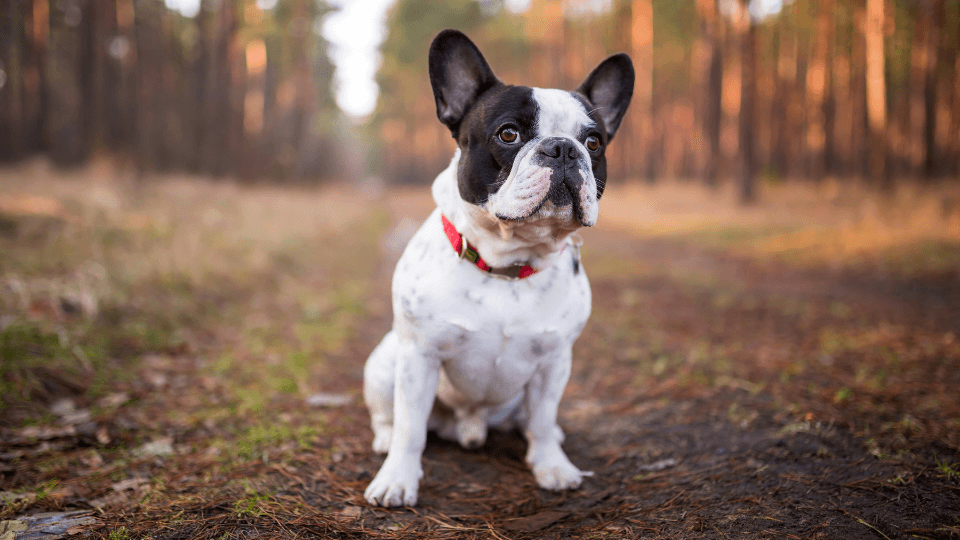Are you thinking of adopting a French Bulldog? According to the AKC, French Bulldogs (also known as Frenchies) are the sixth most popular dog breed in the United States. With their big bat ears and adorably wrinkled face, these rare dogs are cute, playful, and a welcome addition to many families.
However, the full French Bulldog profile will reveal certain health issues that are very prevalent among the breed and often expensive to treat. To help you plan ahead and be the best pet parent you can be, we've compiled a complete French Bulldog care guide that covers everything from Frenchie facts to training tips, care considerations and more.
Table of Contents
- French Bulldog history
- French Bulldog characteristics
- French Bulldog care guide
- French Bulldog health issues
- Where to get a French Bulldog
- Key Takeaways
Pro Tip: Want to be reimbursed for your Frenchie’s vet bills? Compare French Bulldog health insurance plans to save on vet costs and provide your beloved pet with the care they deserve.
French Bulldog history
The French Bulldog hails from England and was created to be a toy-size version of the Bulldog. The breed was very popular among lace makers and when many of these workers emigrated to France, they were accompanied by their miniature Bulldogs.
The US saw its first French Bulldog in the late 1800s when the breed became popular with women of the upper class. The breed was officially recognized by the American Kennel Club in 1898 and has gradually grown in popularity, becoming one of the top ten breeds in the States, the UK, and Australia.
French Bulldog characteristics
Physical appearance
Frenchies are best known for their distinctive large “bat-like” ears and wrinkly faces inherited from their ancestor, the English Bulldog. Their small and dark eyes placed just above their muzzle are quite expressive and can show curiosity, interest, and alertness.
French Bulldogs are small dogs, weighing from 16 to 29 lbs and measuring from 11 to 12 inches high at the shoulders. But although they’re small, these dogs are heavy-boned and have sturdy, muscular bodies with stocky legs, muscled chests, strong necks, and short thick tails.
Finally, this breed boasts a smooth and soft coat. Frenchies come in different colors, (including white, black, brindle, cream, and fawn), color combinations, and markings. Like all breeds, female Frenchies are usually smaller than males.
French Bulldog temperament
The French Bulldog temperament is playful and quirky, suitable for families with or without kids and individuals. They can also get along with other dogs and cats if properly socialized during puppyhood.
Frenchies rarely bark and require minimal exercise, which is why they’re so popular among city dwellers. However, they do require a great deal of grooming and cleaning and may suffer from separation anxiety.
French Bulldog lifespan
The lifespan of a French Bulldog is 11 to 13 years on average. Understandably, keeping your pup happy and healthy will contribute to the quality and length of their life.
French Bulldog care guide

Exercise and training
In terms of French Bulldog physical requirements, a short, daily walk every day should be sufficient exercise, especially when it's over 80 degrees Fahrenheit outdoors. Due to their short muzzles, Frenchies are prone to breathing problems and can overheat very quickly, so watch for signs of heat stroke in dogs to prevent overexertion.
Proper training and early socialization are recommended. The French Bulldog temperament can be a bit stubborn and may require a fair amount of training, but proper motivation and turning the process into a game should ensure their cooperation. Consistent training is essential to ensure your Frenchie grows up to be a well-behaved adult.
Grooming requirements
French Bulldogs have short coats that shed minimally. Weekly brushing promotes the growth of new hair and helps distribute skin oils throughout the coat to keep it healthy. Be sure to keep your pet’s deep skin folds dry and clean, and trim their nails on a regular basis.
Diet and nutrition
French Bulldogs are prone to obesity, which can have a negative effect on their physical structure and put them at an increased risk for health issues, which is why you need to keep an eye on their calorie intake.
Feed a meal of approximately 3/4 cup of high-quality dog food appropriate to your pet’s age twice or three times a day, plus plenty of fresh water, especially on hot days. The exact amount your Frenchie needs will depend on their age, size, level of activity, etc. but your veterinarian can help you determine how much food you should give.
French Bulldog Growth & Weight Chart
If you also want to give your Frenchie treats, make sure to feed them in moderation (treats should make up no more than 10% of your dog’s daily calorie intake). Avoid cooked bones, high-fat foods, and table scraps. Learn about which human foods are safe for dogs and which aren’t.

French Bulldog health issues
Like all flat-faced (brachycephalic) dog breeds, French Bulldogs are prone to breathing issues and often experience problems during hot or humid weather. Some of the most common conditions that affect this breed include brachycephalic obstructive airway syndrome (BOAS), allergies, and skin issues.
Conditions such as luxating patella (or patellar luxation, a kneecap that moves out of its normal location) and hip dysplasia can be caused by genetics or by old injuries. Other back and spine conditions affecting Frenchies include degenerative myelopathy (a progressive disease of the spinal cord in older dogs), IVDD (or Intervertebral disk disease, a ruptured, bulging, slipped, or herniated disk in your dog's neck or back), and spinal disc issues.
They also occasionally suffer from eye conditions like juvenile cataracts, entropion (an abnormality of the eyelids in which the eyelid rolls inward), or cherry eye (a disorder of the nictitating membrane, also called the third eyelid).
Dogs bred by high breed standards are less likely to inherit some of these health conditions. Reputable breeders will perform tests to screen their breeding stock for inherited diseases, such as patella evaluation, cardiac exam, hip evaluation, and ophthalmic evaluation.
Pro Tip: French Bulldogs do have their share of health issues, which is why it is a good idea to sign your Frenchie up for pet insurance while they are still a puppy.
Where to get a French Bulldog
If you're interested in adopting a French Bulldog, get in touch with rescue groups like the French Bulldog Rescue Network. You might also explore dogs that look like French Bulldogs, such as Pugs, English Bulldogs, and Boston Terriers.
Once you adopt or buy a Frenchie, schedule your first vet visit as soon as possible for a full health exam. Your vet can help you with a preventive plan to keep your new pet healthy and living a long life.
Key Takeaways
- The French bulldog, or Frenchie, is a sturdy dog breed with a big head, short snout, and bat-like ears.
- The Frenchie is a distant relative of the English bulldog; they share some characteristics but are two distinct dog breeds.
- As Frenchies are prone to obesity and have a lower exercise tolerance, be sure to keep an eye on your dog’s portions in order to prevent weight gain.
- Common health issues include respiratory system disorders, eye disorders, allergies, skin conditions, as well as back and spine issues.
